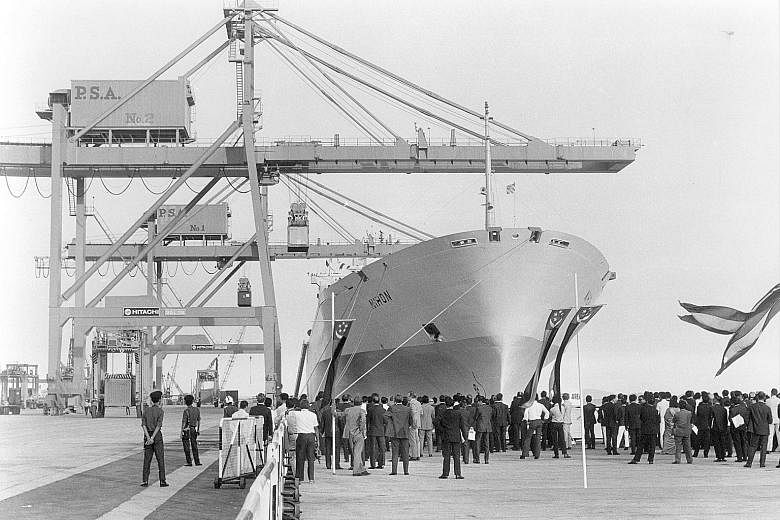For 45 years, it has served as a visual cue for the health of the Singapore economy.
The iconic Tanjong Pagar Terminal - just a stone's throw from the city's commercial centre - has been a significant cornerstone of Singapore as a global port city.
Now, as the Republic expands its port operations in the west of the country, the oldest container terminal is set to give way to the future Greater Southern Waterfront city once its port lease expires in 2027.
Back in the late 1960s, container ships plying trade routes to South-east Asia were unheard of.
But key decision-makers at the then Port of Singapore Authority took the gamble of building a container terminal at East Lagoon (today's Tanjong Pagar) and secured a $45 million loan from the World Bank to help fund the construction.
When Tanjong Pagar Terminal opened on June 23, 1972, it made waves not just as the country's first container terminal, but also as the first such facility in South-east Asia.
At the port's opening ceremony, then Minister for Communications Yong Nyuk Lin told an international audience: "Singapore has therefore made a quantum leap today, into the container era... able to deal right away with the larger, more sophisticated and latest type third-generation container ship with the official opening of its container port. This is as it should be."
It received its first container ship that day - the MV Nihon, which sailed into port from Rotterdam, carrying about 300 containers.
Global container shipping really started only in the early 1970s. Container trade here got off to a slow start that decade but grew in a big way during the 1980s, thanks to rapidly expanding world trade, which boosted Singapore's ambitions as a global container port.
By 1982, Singapore had grown to become the world's busiest port by shipping tonnage, and managed to handle one million standard cargo containers a year for the first time - a milestone Tanjong Pagar Terminal played a big part in. Singapore crossed the five million box mark eight years later to become the world's largest container port.
Today, the Port of Singapore continues to rank among the world's busiest, and as the top transshipment hub globally. The maritime industry accounts for 7 per cent of Singapore's gross domestic product and employs over 170,000 people.
The Tanjong Pagar Terminal that Mr Teo Siong Seng of home-grown shipping line Pacific International Lines (PIL) remembers back in the 1970s was full of bustle - forklifts, trucks, clerks and stevedores were constantly moving in and out, and it was messy and dirty at times.
As a 15-year-old student back in the day, he had taken on his first holiday job as a tally clerk for ships.
"But that was the nature of the trade back then. I was awed by the people driving the cranes and the stevedores handling the cargo, the way things were moving so fast, and I had to be careful not to get in the way. You don't see this any more," says Mr Teo, PIL's managing director, better known in industry circles as S.S. Teo. "We've come a long way from when we first received the MV Nihon," he tells The Straits Times.
He officially entered the industry in 1979 when he joined PIL, his father's company. "I remember there used to be these tongkangs or tuakor (light wooden boats for carrying goods) that were phased out in the early 90s as Pasir Panjang Terminal was being built. The ships had to be punctured with holes and sunk so people could be convinced to let go. It was quite emotional," he recalls.
"But it's the passing of an age. Now you have all these container berths that are unmanned, so there is a lot of difference, but that is progress. We have to keep moving forward."
Work on the new port in Tuas is already under way, with reclamation ongoing for two out of four phases of the development.
Ocean Shipping Consultants director Jason Chiang believes it makes more sense economically for PSA to combine its operations at a single location now, in the light of the unprecedented wave of consolidation that the container shipping industry has seen since last year.
"Most of its customers, the container shipping lines, have decided to merge or buy over each other. So having four or five separate terminals to service fewer players, who probably want their ships to call at dedicated berths at the same location, doesn't make sense," Mr Chiang notes. "They could even try to speed up plans for Tuas."
For now, Tanjong Pagar Terminal - Singapore's oldest container terminal - will continue to offer ancillary services such as car transshipment, and serve occasional calls by container vessels, says a PSA spokesman. He adds that PSA plans to hold an event later this year to honour the role that the terminal has played in Singapore's port history.
In 2008, at the inaugural Singapore Maritime Lecture, then Minister Mentor Lee Kuan Yew had described the port as Singapore's reason for existence.
"Singapore's raison d'etre was its port; Singapore must strive to remain a major hub port."


